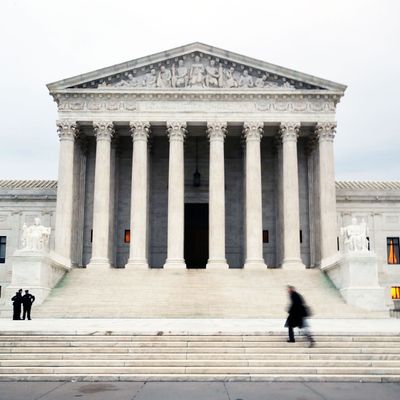
Last October the U.S. Supreme Court held oral arguments on a genuinely major case (Gill v. Whitford) in which a lower court had struck down a state legislative map that Wisconsin Republicans had devised to maximize their control of the state. It offered SCOTUS the chance to finally strike a blow against partisan gerrymandering (traditionally accepted by the courts, in contrast to racial gerrymandering, as a political question beyond the judiciary’s reach), which it had come close to taking on in a 2004 decision wherein Justice Kennedy struggled with the issue but concluded no one had provided a clear and reliable standard for measuring excessive partisanship. With the rest of the Court pretty clearly split between its clear-cut liberal and conservative four-justice blocs on the advisability of intervening in such cases, Kennedy has remained the swing vote on this subject to this day.
Accordingly, the plaintiffs in the Wisconsin case tailored their challenge to partisan gerrymandering to Kennedy’s concerns, coming up with a mathematical standard (called the “efficiency gap”) for determining how far mapmakers with partisan motives have strayed from fair decisions. And Court-watchers like Ian Millhiser were optimistic about Kennedy’s behavior during oral arguments:
Justice Anthony Kennedy, the Court’s “swing” vote in this case, asked a number of critical questions of the lawyers defending the gerrymandered maps and literally no questions of Smith. At one point, he appeared to grow angry with an attorney defending the maps for not answering one of his questions.
Though it is up in the air how deeply the Court will cut into the practice of partisan gerrymandering, a smart gambler would bet on Wisconsin’s maps going down.
When in December the Court accepted a second partisan gerrymandering case from Maryland, optimists found reason to think that was a positive development as well. For one thing, that case involved a Democratic gerrymander; perhaps the Justices wanted to balance a decision overturning one party’s gerrymander in Wisconsin with another’s in Maryland (the appearance of partisan judicial motives seemed to be a big deal to Chief Justice Roberts in the Wisconsin oral arguments). For another, the challengers in Maryland (who lost at the district-court level) were offering a First Amendment rationale against partisan gerrymandering which might be attractive to Kennedy’s First Amendment preoccupations.
Today’s oral arguments in the Maryland case (Benisek v. Lamone) are generating more fog than light in terms of the Court’s direction on partisan gerrymandering. For one thing, the Justices got very bogged down in the procedural question of why the challengers were asking for an injunction to immediately overturn a districting scheme that had been in place for so long, particularly when relief would likely occur too late to change anything before the 2018 elections. And the fact that the case involved a challenge to a single district, not to an entire map, made use of the tools deployed in the Wisconsin case problematic. As SCOTUSblog’s Amy Howe concluded: “There was no obvious consensus among the justices on how courts should determine when politics has played too strong a role in redistricting.”
But there was an even more immediate problem for those hoping that before the end of the current term the Court would issue a landmark decision outlawing partisan gerrymanders: one of the Justices thought to be in the pro-reform camp, Stephen Breyer, seemed to push for SCOTUS to bring in a third case (from North Carolina) and take its time. As AP’s Mark Sherman noted, this was not a good sign for the anti-gerrymandering cause:
Breyer’s comment is an indication that the justices haven’t figured out the Wisconsin case in the nearly six months since it was argued.
More importantly, it suggests that Justice Anthony Kennedy, whose vote almost certainly controls the outcome, has reservations about using the Wisconsin case for the court’s first-ever ruling that districting plans that entrench one party’s control of the legislature or congressional delegation can violate the constitutional rights of the other party’s voters.
Pema Levy summed up the murky situation:
As the Supreme Court heard a major case on gerrymandering on Wednesday, two things became clear: The justices generally seem to agree that gerrymandering is a problem, but they are struggling to figure out what to do about it.
While opponents of partisan gerrymandering are understandably eager for a landmark ruling, it’s really not a 2018 issue, and the big consequences won’t be felt until after the 2020 census when the next decennial round of redistricting begins. Perhaps Breyer has reason to believe a more deliberate approach will not only bring Kennedy around but will lead to a more comprehensive decision (one that only focused on the Maryland situation, for example, might require time-consuming district-by-district challenges for purposes of implementation). But without question, even as Breyer provided the most troubling hint of the Court’s indecision on this subject, he also issued the clearest warning of why the judiciary needs to act, if at all, before 2022:
Breyer further cautioned that if the court doesn’t take action on partisan gerrymandering, advanced technology will allow lawmakers to draw even more extreme gerrymanders in the future.
And the former optimist Ian Millhiser also had a reminder of a different time-sensitive consideration:
Whatever the Court says, there’s no guarantee it will do so quickly, and that raises another dark shadow over this case. Justices Kennedy and Ginsburg are in their 80s, and Justice Breyer is 79. Kennedy is rumored to be considering retirement.
If the anti-gerrymandering majority waits too long, it could become a minority. And then there could be no solution to gerrymandering for decades to come.
Ticktock.






























